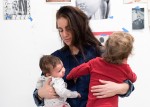This post was updated on May 23 at 12:59 p.m.
Over two thousand childbirth photographs covered the walls of New York’s Museum of Modern Art in 2018.
Society often depicts birth as agonizing and grotesque, but artist Carmen Winant aims to break the stigma through her collages. The alumna will give a talk at the Hammer Museum on Thursday discussing her artistic process, specifically in regards to her MoMA project, “My Birth.” She said she will speak about her journey as a collage artist and the reasons she was drawn to such unconventional subject matter.
“I wanted to explore projects that made me feel vulnerable but also artistically challenged,” she said. “Taking pictures of pictures can be beautiful, too.”
At first, Winant felt skeptical about creating collages because she thought it fit into the stereotype of crafting as an art form exclusively for women. And Winant said she didn’t want her artwork to appear domestic or limit her creativity in any way. And as a young artist, Winant thought she would have to portray herself as more masculine in order to make radical changes. She said her own internalized sexism made her believe she would never be taken seriously.
But after taking a class with UCLA professor Catherine Opie, she said she began to trust her creative impulses, regardless of societal stigmas or stereotypes. The ability to explore multiple perspectives within a single piece drew her to collage art, as she was able to create a new visual language, she said.
“My artwork is representative of a journey,” she said. “It’s a window into a very private world that is often tainted by mainstream media, pop culture and entertainment.”
Before the birth of her first son, Winant said she didn’t realize how underrepresented childbirth was in the art world and how little it is talked about in everyday conversation. Its lack of prevalence makes it mystifying but leaves room for misconceptions, she said. Childbirth is spiritual, shocking, unpredictable and beautiful, Winant said, and she wanted to convey those distinct emotions through intimate imagery of the atypical subject matter.
At times the women appear strong and confident. At other times the images feel raw or frightening, because they portray the birthing experience in an unfiltered and graphic way, she said. Winant said she overlaps found images to create collage work that allows people to question the norm.
Along with collage, Winant also wrote and illustrated a book based off her childbirth-themed project. Bruno Ceschel, publisher of “My Birth,” said the book is a collection of photographs and writings that explore themes of both literal and figurative rebirth.
The book incorporates images from the artist’s family albums and narrative reflections written by Winant herself. There’s a chronological story being told, with Winant’s mother as the recurring protagonist. Her work is a visual representation of topics that are often considered taboo and are rarely explored through art, Ceschel said.
“It’s a visceral experience for viewers and readers to be confronted by such graphic images and stories,” he said. “But her art poses questions that form a powerful gender framework.”
Much of Winant’s work focuses on feminist ideology, Ceschel said. Winant said she integrates themes of female resilience into her work, featuring images of women at varying points in the birthing process to elicit different emotions or experiences.
Expanding on the topic of female dimensionality, Winant also has a body of work entitled “Who Says Pain is Erotic?” in which she illustrates the complex intersection of pain and pleasure. Fabiola Alondra, co-founder of the Fortnight Institute in New York, said her gallery displayed work from this project, which features images of women’s bodies coated in red food dye. Alondra said she was drawn to Winant’s art because of its strong political message.
Winant’s collages question why women are often portrayed as the primary receivers of pain, questioning how intimacy can quickly turn to violence, she said. Winant uses her collages as instruments for social change and women’s empowerment, Alondra said.
“The underlying feeling in my work is the underlying feeling in my life. I try to peel back the harmful social layers that we so willingly accept,” Winant said. “The patriarchy is oppressive in every corner of the world, in profound, horrifying and striking ways.”
